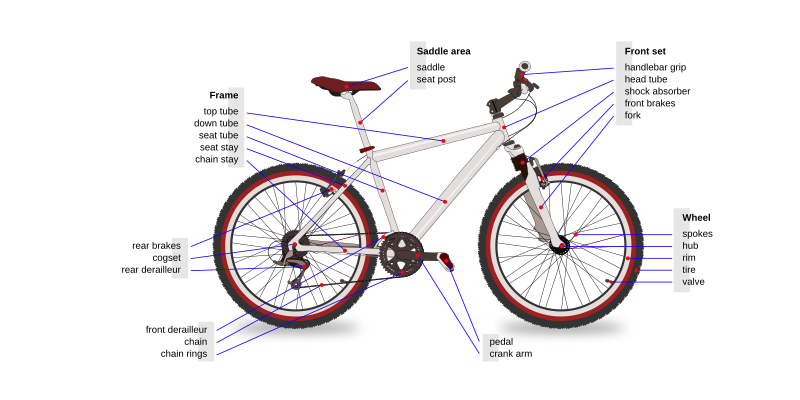 The bicycle is made up of many components, the great majority of todays bikes have an upright seating position looking forwards toward the steering system. Upright bicycles as pictured above often always feature the diamond frame, a truss consisting of two triangles, the front triangle and the rear triangle. The front triangle consists of the head tube, top tube, down tube and seat tube. The head tube contains the headset, the set of bearings that allows the fork to turn smoothly for steering and balance. The top tube connects the head tube to the seat tube at the top , and down tube connects the head tube to the bottom bracket. The rear triangle consists of the seat tube and paired chain stays and seat stays. The stays run parallel to the chain, connecting the bottom bracket to the rear dropouts. The stays connect the top of the seat tube (at or near the same point as the top tube) to the rear dropouts.
The bicycle is made up of many components, the great majority of todays bikes have an upright seating position looking forwards toward the steering system. Upright bicycles as pictured above often always feature the diamond frame, a truss consisting of two triangles, the front triangle and the rear triangle. The front triangle consists of the head tube, top tube, down tube and seat tube. The head tube contains the headset, the set of bearings that allows the fork to turn smoothly for steering and balance. The top tube connects the head tube to the seat tube at the top , and down tube connects the head tube to the bottom bracket. The rear triangle consists of the seat tube and paired chain stays and seat stays. The stays run parallel to the chain, connecting the bottom bracket to the rear dropouts. The stays connect the top of the seat tube (at or near the same point as the top tube) to the rear dropouts.Bicycles nowadays are made from a variety of material, historically the materials used in bicycles have followed a similar pattern as in aircraft, the goal being hight strength and low weight. Since the late 1930s alloy steels have been used for frame and fork tubes in higher quality machines. Aluminum alloys are increasingly used in components such as handle bars, seat posts and brake leavers. In the 1980s aluminium alloy frames became popular for the lightness, and their affordability now makes them common. Move expensive carbon fibre and titanium frames are now also available, as well as advanced steel alloys and even bamboo.

Nice blog dear I like the way as you present your view among the all visitors. I would like to join you again on this blog it’s a very nice visit on this blog. It’s very attractive and effective for visitors. Pressure Die Casting Machines, Aluminium Components
ReplyDelete